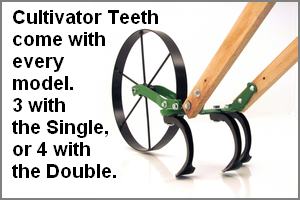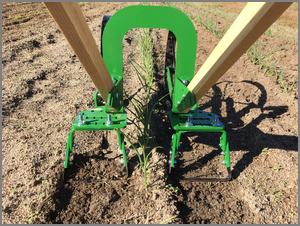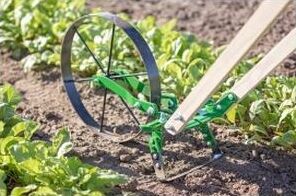Wheel Hoes - Selection, FAQ, and more
Click here to jump down to the FAQ section
- Cultivator Teeth
- Plows
- Weeding Hoes
- Disc Harrow
- and more!
How To Select The Right Wheel Hoe
We have two different models to choose from:
- the Hoss Wheel Hoe (as a single or double wheel version)
- the High-Arch Wheel Hoe (double wheel only)
Choose your wheel hoe based on the TASKS you want to use it for:
1. Either model will work for...
- basic cultivating and weeding
- plowing, hilling, and furrowing
2. Only the Hoss Wheel Hoe works if...
- using the Disc Harrow attachment
3. Either model will work for...
- straddle weeding* small crops (like carrots)
- (if Hoss model is in double wheel mode)
4. Only the High Arch model works if...
- straddle weeding* tall crops (like corn)
*Click for:
HOSS Wheel Hoe (single or double)
The original Hoss model is the most popular wheel hoe!
It has more useful attachments than any other brand of wheel hoe.
The Single Wheel model is easy to steer, and the Double Wheel version increases your weeding options.
Single Wheel model with cultivator teeth = $269
Double Wheel model with cultivator teeth = $309
Choose model ▶


Includes: Single or Double Wheel unit, and Cultivator Teeth. More Info...
Single Wheel package =
$372 $359
Double Wheel package =
$412 $399
Choose model ▶




Includes: Single or Double Wheel unit, Plow Set, 8" Oscillating Hoe, and Cultivator Teeth. More Info...
HIGH ARCH Wheel Hoe
The Hoss High Arch model excels at weeding, cultivating, or plowing BOTH sides of a row of crops at the same time. This technique is called "straddling" and it literally cuts your work in half.
● Straddle cultivating with the teeth loosens the soil on both sides at once.
● Straddle weeding slices weeds left and right with the same amount of effort.
● Straddle plowing (hilling) moves soil up & over the base of plants like corn & potatoes.
● Click to see all the Hoss Attachments
Base model with cultivator teeth = $399
Choose model ▶ In Stock


Includes: Double Wheel High-Arch unit and 4 Cultivator Teeth. More Info...
LOADED High-Arch
Base model + accessories =
$536 $519




Includes: Double Wheel High-Arch unit, Plow Set, two of 6" Oscillating Hoes, and 4 Cultivator Teeth. More Info...
Frequently Asked Questions (FAQ) About Wheel Hoes
Click or tap a question below to see the answer.
What is a wheel hoe used for?
How is a wheel hoe used?
What are the advantages of using a wheel hoe?
What is the difference between a single and double wheel hoe?
What is Straddle Weeding?
Which brand of wheel hoe should I buy?
What attachments are available for different wheel hoes?
Why is a wheel hoe also called a Wheel Cultivator?
What does a wheel hoe Hiller do?
What does it mean to back cut while using a wheel hoe?
How does a wheel hoe compare to a rototiller?
What is the History of the wheel hoe?
Is a wheel hoe worth it?
What is a wheel hoe used for?
- Wheel hoes are garden tools pushed through rows to weed, till, cultivate or plow. They feature a wheel in the front, a tool-mounting area in the middle, and handles for pushing in the rear.
- Click to see our article: What a Wheel Hoe is used for
How is a wheel hoe used?
- When using a wheel hoe, first choose the right attachment for the job. Such as a plow, hoe, or cultivator tines. Keep your hands level while pushing the wheel hoe. Try to walk steadily forward, using your leg muscles rather than your arm and shoulder muscles.
- Click to see our article: How a Wheel Hoe is used
What are the advantages of using a wheel hoe?
- Wheel hoes provide increased productivity, less strain on the user's body, and more accurate results compared to other tools like rototillers or garden hoes.
- Click to see our article: Advantages of a Wheel Hoe
What is the advantage of using a wheel hoe instead of a rototiller?
- The wheel hoe is easier to maneuver and control than a rototiller. It is peaceful and has no engine that needs maintenance. They also last longer than a tiller.
What is the advantage of using a wheel hoe instead of a garden hoe?
- It takes much less time and effort to cultivate and weed with a wheel hoe compared to using a garden hoe.
What is the difference between a single wheel hoe and a double wheel hoe?
- A single wheel hoe has one centered wheel in the front. A double wheel hoe has two parallel wheels about six inches apart, though the spacing is adjustable on some models.
- Click to see our article: Single versus Double Wheel Hoe
What is the advantage of using a single wheel hoe?
- The single wheel hoe allows more precise steering, is easier to maneuver in tight spaces, and is lighter. It is also less expensive and easier to set up.
What is the advantage of using a double wheel hoe?
- The double wheel hoe is able to straddle weed some crops, which can decrease weeding time in large commercial gardens. It will also easily stand on its own when you let go of the handles.
How to choose between a single and double wheel hoe?
- Factors to consider when choosing between single and double wheel hoes include: type of crops you grow, the size of the garden, your desire to straddle weed or straddle cultivate, maneuverability, and the cost.
What is Straddle Weeding?
- Straddle weeding is weeding both sides of a row of crops simultaneously. It is done with a double wheel that has two weeding attachments, one to the left and the other to the right. It decreases the weeding time in gardens or fields that have many rows of the same crop. The wheel hoe travels over the row with one wheel on each side, while the weeding attachments scrapes the weeds loose on both sides of the row. Short crops can be done with any double wheel hoe, while tall crops (like young corn) require the added clearance of a High Arch wheel hoe.
- Click for videos of: How to Straddle Weed
Which brand of wheel hoe should I buy?
- Choose a brand that has the attachments you need. There are four modern wheel hoe brands (Glaser, Hoss, Valley Oak, and Terrateck) available in the USA. Each comes with different features, attachments, and widely varied prices.
- Click to see our: Wheel Hoe Buying Guide
What sort of attachments are available for wheel hoes?
- Available attachments include those for cultivating, weeding, plowing, and specialty tasks.
- Click to see our article: Attachments for All Brands of Wheel Hoes
What are cultivator attachments for a wheel hoe?
- Cultivating attachments loosen and aerate the upper layer of soil. They are also great for large weed removal.
What are weeding attachments for a wheel hoe?
- Weeding attachments cut or drag small weeds through the top-most layer of soil, leaving the underlying soil's structure intact.
What are plowing attachments for a wheel hoe?
- Plowing attachments move soil by cutting deeply and pushing or rolling the dirt upwards and to the side.
What are specialty attachments for a wheel hoe?
- Specialty attachments are useful for very specific jobs, such as laying drip tape or preparing a seed bed.
Why is a wheel hoe also called a Wheel Cultivator?
- The most common attachment for wheel hoes are cultivator teeth or tines, which are pushed through the soil to stir it. Cultivating is the process of loosening the top layer of soil, improving air circulation, water absorption and nutrient availability. Since this is the most common use, wheel hoes are often called wheel cultivators.
- Click to see our article: Cultivating with a Wheel Hoe
What does a wheel hoe Hiller do?
- A hiller is a plow like attachment used for hilling. Hilling is the process of pulling up path soil and piling it amongst a row of tall crop plants to bury and smother small weeds that have sprouted between the crop plants. Hilling one side of row at a time can be done with a single-wheel hoe and a single plow. While straddle hilling (piling soil on both sides of the row at once) requires a double-wheel hoe and a pair of opposing plows.
- Click to see our article: How To Do Hilling with a Wheel Hoe
What does it mean to back cut while using a wheel hoe?
- Back cutting is done with a weeding attachment called an Oscillating Hoe fastened to a wheel hoe. This double-sided blade has a pivot mechanism to let it cut or scrape weeds in both directions. The oscillating hoe is mostly used by pushing the machine forward (forward cutting). Back cutting involves pulling the wheel hoe backwards over a tough weed or dense weedy spot while lowering the handles to tilt the front wheel off the ground. This puts the entire weight of the wheel hoe onto the Oscillating Hoe's blade so it can cut and scrape aggressively.
- Click to see our article: The Power of the Back Cut
How does a wheel hoe compare to a rototiller?
- Wheel hoes are better for light cultivation and control of small weeds, while tillers work better for breaking up sod, turning under compost, and loosening hard soils. Wheel hoes are less expensive, quieter, less polluting, and more maneuverable than tillers. Other differences include user safety and maintenance costs.
- Click to see our article: Rototiller versus Wheel Hoe Comparison
What is the History of the wheel hoe?
- In 1890, the SL Allen Company began selling various Planet Jr models. These were lightweight, multipurpose machines that farmers pushed. They specialized in wheel hoes and seed drills that allowed four-fold efficiency increases over crop management with garden hoes. Home gardeners soon realized that vegetable gardens could be redesigned to make the most of wheel hoe efficiency, which generated a larger system of gardening.
- Click to see our article: The History of the Wheel Hoe in America
Is a wheel hoe worth it?
- Yes, it is. For a cost of $300 to $700 a wheel hoe will be two to ten times faster and reduce muscle effort compared to a garden hoe when weeding or cultivating. And compared to a rototiller, using a wheel hoe requires much less investment, fuel, and maintenance - yet still provides efficient cultivation of soil with the added ability to weed, furrow, and hill.
- Click to see our article: A wheel hoe is a worthwhile investment
What is special about the Loaded packages?
Years ago, we noticed lots of people buying plows and oscillating hoes with their basic wheel cultivators.
So we made packages out of them to make your decision easier, and save you some money.
Both of the Loaded packages do save some money over buying the same components separately.
If you want to add even more wheel hoe attachments, you can find them all listed on the
Attachments page.
See all of our:
Click for all:
See the:

